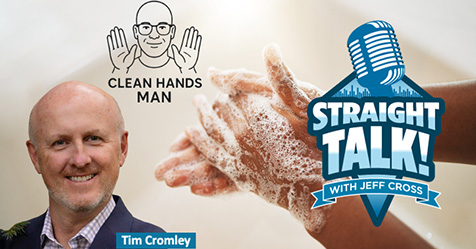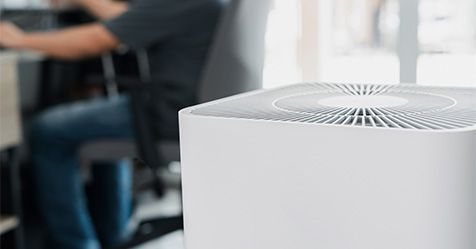An article published in August 2020 by the Cleveland Clinic discusses how long the coronavirus—the pathogen that causes COVID-19—lives on surfaces. According to the authors, “While COVID-19 is mainly spread by inhaling tiny droplets released when an infected person talks, coughs, or sneezes, large droplets can also land on surfaces.” Further, “A healthy person can then unknowingly touch those surfaces, and the next thing you know—the virus has gotten a free ride to wherever and whatever the person touches.”
The article outlines how long the virus typically lasts on different surfaces:
- Glass: five days
- Wood: four days
- Plastic and stainless steel: three days
- Cardboard: 24 hours
- Copper: four hours.
Many reputable sites report a similar life span for the virus on surfaces: two to five days. However, is this correct?Given the cleaning industry’s central role in fighting the pandemic—and the heavy use of disinfectants to do so—the answer to this question is crucial for cleaning professionals to know.
Disinfectants are an essential cleaning product because they kill pathogens and microorganisms. However, they can also be harmful to the person applying the disinfectant, to building users, and to the environment. With the uptick in disinfectant use due to COVID-19, those harmful effects are becoming more of a concern.
A June 2020 article in Bloomberg Law suggests that we are overusing disinfectants to the point that it is replacing one problem with another. These are “hugely toxic chemicals,” says Claudia Miller, immunologist, allergist, and co-author of the book “Chemical Exposures: Low Levels and High Stakes.” “We’re creating another problem for a whole group of people, and I’m not sure we’re actually controlling infections.”
The best way to address this concern may be to investigate if the pathogen that causes COVID-19 does live on surfaces for as long as is being reported. If it does, we may have no choice but to increase cleaning frequencies and use large amounts of disinfectants.
But if the pathogen does not live that long on surfaces, we may need to consider an entirely different cleaning strategy.
Disputing the coronavirus life span on surfaces
A study published in the August 2020 issue of the British medical journal The Lancet takes issue with the life span that has been popularly cited for the coronavirus. The study suggests that the virus may, in some cases, live only a few hours on surfaces, not several days.
According to the author, Emanuel Goldman, professor of microbiology, biochemistry, and molecular genetics at Rutgers University’s New Jersey Medical School, “A clinically significant risk of severe acute respiratory syndrome coronavirus 2 (SARS-CoV-2) transmission by fomites (inanimate surfaces or objects) has been assumed based on studies that have little resemblance to real-life scenarios.”
Goldman goes on to explain that in one study, the virus survived on a surface for six days but that this was accomplished by placing a very large sample of the virus on the surface being tested.
He describes how several studies have used exceptionally large samples on their test surfaces—more than we would be expected to encounter in the real world. Further, he says the samples were not allowed to dry out, which typically would happen if the pathogen were to land on a desk or the top of an office chair.
“None of these studies present scenarios akin to real-life situations,” says Goldman. “By contrast, one study found human coronavirus 229E to survive for only three to six hours (depending on the surface tested) and human coronavirus OC43 to survive for one hour after drying on various surfaces including aluminum, sterile latex surgical gloves, and sterile sponges.” Coronaviruses of types 229E and OC43 are common human coronaviruses that cause upper-respiratory tract illnesses and are distinct from the 2019 novel coronavirus.
Goldman says he does not dispute the findings of other studies when it comes to the life span of the virus on surfaces; he just does not believe that humans would be exposed to such large amounts of the virus. He ends his report by saying, “In my opinion, the chance of transmission through inanimate surfaces is very small and [would occur] only in instances where an infected person coughs or sneezes on the surface and someone else touches that surface soon after they cough or sneeze (within one to two hours).”
Where does that leave the cleaning industry?
John Richter, an advisor to cleaning equipment manufacturer Kaivac, presenter at the Cleaning Industry Research Group (CIRI) and now a professor at Miami University in Oxford, Ohio, has two answers to the question of what this information means for the cleaning industry.
His first answer is rooted in common sense: “This is just one report by one specialist in the field. It will likely trigger other studies. If more studies come out supporting Goldman’s view, then we know the life span of the virus may be shorter than we think. Until then, we should follow current guidelines, especially those outlined by ISSA and GBAC.” The Global Biorisk Advisory Council® (GBAC) is a division of ISSA that helps organizations and businesses prepare for, respond to, and recover from biological threats, and biohazard situations.
Richter’s second answer is based on reports from the U.S. Centers for Disease Control and Prevention (CDC). In its reopening guidance for public spaces, businesses, and schools, the CDC states that in most cases, effective cleaning is all that is needed to stop the spread of COVID-19 and other diseases.
However, a great deal of this effectiveness depends on how these surfaces are cleaned.
For instance, we have known since the early 1970s that mops can spread contamination. From the moment mops are used in the cleaning process, they collect pathogens and spread them over the floor. This is likely one reason a 2017 study by researcher Abhishek Deshpande and others published in the American Journal of Infection Control found that floors in hospital patients’ rooms are frequently contaminated with disease-causing pathogens.
One way to eliminate the use of mops when cleaning floors is by using what ISSA refers to as spray-and-vac cleaning systems. With these machines, fresh cleaning solution is applied to the floor and no mops are used in the cleaning process. Some systems even vacuum up moisture, removing pathogens from the just-cleaned area.
Richter’s reflections about the Goldman study provide good advice for the professional cleaning industry. To pinpoint the life span of the virus, more studies need to examine the issue. As for cleaning, we have known for decades about the strong connection between cleaning and health—and the pandemic has made this connection more evident than ever before.




